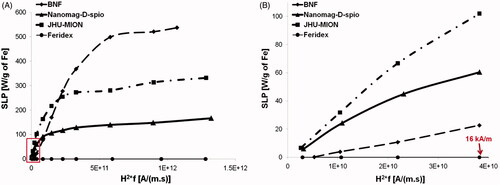Figures & data
Figure 1. (A) Schematic of a hysteresis loop showing the important parameters. (B) Hysteresis loops as a function of frequency on a magnetic nanoparticle system. (Reprinted with permission from Eggeman et al. [Citation48].).
![Figure 1. (A) Schematic of a hysteresis loop showing the important parameters. (B) Hysteresis loops as a function of frequency on a magnetic nanoparticle system. (Reprinted with permission from Eggeman et al. [Citation48].).](/cms/asset/2c4e8cce-5807-41e2-a3fd-329e3ae9689f/ihyt_a_836758_f0001_b.jpg)
Figure 2. (A) SLP generated by four different magnetic nanoparticle systems dispersed in water as a function of maximum magnetic field at a fixed frequency of 150 kHz. Highlighted area in (A) is shown in (B) as a close-up of the SLP in low field amplitudes. (Figure courtesy of Anilchandra Attaluri.).

Figure 3. Minor loops for randomly oriented nanoparticles with fixed magnetic field amplitude (10 Oe) and fixed frequency as a function of magnetic anisotropy energy density in ergs/cm3, where K = (A) 1 × 105, (B) 2 × 105, (C) 3 × 105, (D) 4 × 105, (E) 5 × 105, (F) 6 × 105, (G) 7 × 105, (H) 8 × 105, and (I) 9 × 105. (Reprinted with permission from Sohn and Victora [Citation60].).
![Figure 3. Minor loops for randomly oriented nanoparticles with fixed magnetic field amplitude (10 Oe) and fixed frequency as a function of magnetic anisotropy energy density in ergs/cm3, where K = (A) 1 × 105, (B) 2 × 105, (C) 3 × 105, (D) 4 × 105, (E) 5 × 105, (F) 6 × 105, (G) 7 × 105, (H) 8 × 105, and (I) 9 × 105. (Reprinted with permission from Sohn and Victora [Citation60].).](/cms/asset/a77b7974-a3da-41a3-92a2-d8da684c7c58/ihyt_a_836758_f0003_b.jpg)
Figure 4. Heat (W, in dimensionless units) produced during one cycle as a function of field amplitude (p0, in dimensionless units where p = mH/U) in 1) liquid, and 2) solid dispersion. (Reprinted with permission from Kashevsky et al. [Citation77].).
![Figure 4. Heat (W, in dimensionless units) produced during one cycle as a function of field amplitude (p0, in dimensionless units where p = mH/U) in 1) liquid, and 2) solid dispersion. (Reprinted with permission from Kashevsky et al. [Citation77].).](/cms/asset/5297b676-2ae6-4897-ba2f-ef95d845fbb7/ihyt_a_836758_f0004_b.jpg)